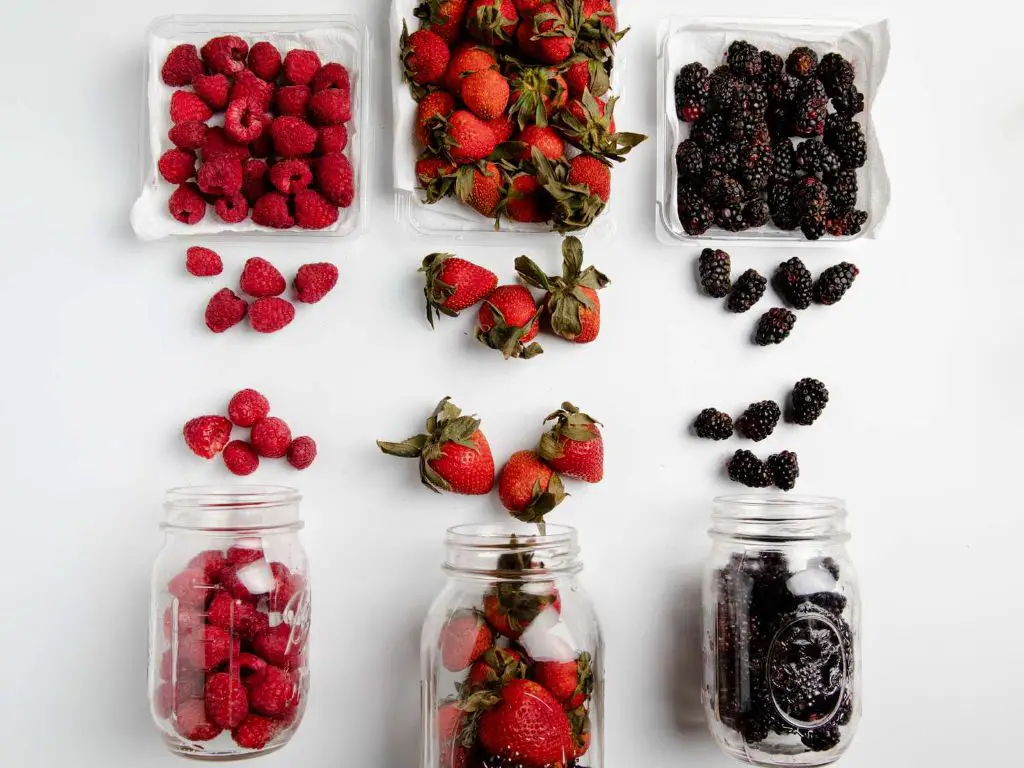Does A Berry Bowl Go In The Fridge?
Berries are a delicious and nutritious addition to many meals and snacks. However, because of their delicate nature, berries also tend to spoil more quickly than other fruits and vegetables. Learning how to properly store berry bowls can help preserve freshness and avoid waste.
The purpose of this article is to provide guidance on the best storage methods for berry bowls. Proper storage can extend the shelf life of berries by a few days or more. We will cover factors that impact berry freshness, recommendations for fridge versus counter storage, signs of spoilage to watch for, and tips for keeping your berries safe to eat.
With the right techniques, you can keep berry bowls fresh and enjoyable for longer!
Defining a Berry Bowl
A berry bowl is a bowl that contains a mixture of fresh berries, typically including blueberries, raspberries, blackberries, and strawberries. It is a bowl filled with an assortment or “mix” of berries. As defined by the Wall Street Journal, “A berry bowl is a pottery vessel about a hand’s width in diameter and perforated with a scattering of small holes, it is essentially a petite ceramic colander.”
The purpose of a berry bowl is to hold and store fresh berries so they are easily accessible for snacking, adding to yogurt or cereal, using in fruit salads, baking, etc. The bowl allows you to rinse and drain the freshly washed berries while also keeping them visible and within reach. Unlike storing berries in a plastic clamshell or closed container, a berry bowl keeps the berries ready to grab and eat.
Berry bowls are typically made of ceramic, glass, or other nonporous materials that can be easily cleaned. The small holes allow airflow and drainage. Some berry bowls have lids while others remain open. The defining characteristic is their petite size, portability, and purpose of holding mixed berries.
Benefits of Berry Bowls
Berries are packed with essential vitamins, minerals, and antioxidants that provide a wide range of health benefits. According to the USDA, berries contain high levels of antioxidants that can help prevent chronic diseases and slow the aging process.
Some key nutrients found in common berries include:
- Vitamin C – Boosts immunity and acts as an antioxidant. Especially high in strawberries, blackberries, and raspberries.
- Fiber – Improves digestive health and heart health. Highest in blackberries and raspberries.
- Vitamin K – Supports bone health and blood clotting. Abundant in blueberries and bilberries.
- Manganese – Involved in bone formation and metabolism. High in cranberries and blueberries.
Regularly consuming a mix of berries can provide antioxidants to fight inflammation, fiber to regulate digestion, and key vitamins and minerals to support overall health. Compounds in berries may also help manage diabetes, improve cognition, and reduce risk of neurodegenerative disease.
Berries contain bioactive compounds that benefit the body in many ways. Building berry bowls into your diet is a delicious way to boost your intake of essential nutrients and antioxidants.
Factors Impacting Berry Freshness
There are a few key factors that can impact how quickly berries spoil and lose their freshness:

Temperature – Berries are very sensitive to temperature. Heat causes berries to deteriorate faster. Storing berries in the refrigerator between 32-40°F helps slow down spoilage and mold growth. Temperatures above 50°F cause berries to decay more rapidly (source).
Humidity – Moisture causes berries to mold and rot more quickly. Storing berries in a container lined with paper towels can help absorb excess moisture and prevent spoilage. Ideal humidity for berry storage is around 90-95% (source).
Ethylene Gas – Ethylene gas is naturally produced by fruits like apples, peaches and plums. It accelerates the ripening process in other fruits and vegetables. Storing ethylene-producing fruits away from berries helps prevent premature ripening and spoilage.
Storing Berries in the Fridge
Refrigerating berries has both advantages and disadvantages when it comes to preserving freshness and extending shelf life. According to research, storing berries in the refrigerator can slow down ripening and decay, which helps them last longer.
The cold temperature of the fridge (around 40°F) reduces the rate of spoilage and moisture loss. It also inhibits mold growth and other microbial actions that cause berries to deteriorate quickly at room temperature (1).
However, refrigerating berries can also damage them in some cases. The cold, dry air of the fridge can cause berries to lose moisture, become soggy, and lose some of their texture and flavor. Condensation that accumulates on the surface of berries promotes spoilage.
Certain delicate berries like raspberries, blackberries, and strawberries are more susceptible to these downsides of refrigeration. The impact depends on factors like ripeness, variety, and how long the berries are refrigerated (2). Prolonged refrigeration of more than 3-5 days is not recommended for fragile berries.
Overall, refrigeration can extend the shelf life of sturdier berries like blueberries and cranberries, but should be done with care and common sense for more delicate types. Following proper storage practices can minimize the downsides.
(1) https://www.quora.com/What-temperature-do-berries-begin-breaking-down-losing-freshness
(2) https://www.facebook.com/TrimHealthyMama/photos/a.394655747254945/1906250136095491/?type=3
Storing Berries at Room Temperature
Storing berries at room temperature has some benefits but also some downsides to consider. According to Martha Stewart, room temperature storage can maximize berries’ flavor and texture compared to refrigeration. However, berries will spoil more quickly at room temperature. Berries like raspberries and blackberries may only last 1-2 days on the counter before molding.
The Eating Well recommends room temperature for short-term storage if you plan to eat berries within a day or two. They suggest keeping berries in a single layer instead of stacked and covering with a paper towel to absorb excess moisture. Overall, room temperature storage works best for berries that will be consumed quickly, but it increases the risk of faster spoilage compared to refrigeration.
Recommended Storage Methods
When it comes to storing your berry bowl, the recommended methods depend on the type of berries and how you plan to use them.
In general, more fragile berries like raspberries, blackberries, and sliced strawberries are best kept in the refrigerator to maximize freshness. The cold environment helps slow down mold growth and keeps their structure intact. Store them in a shallow container lined with paper towels to absorb excess moisture.
Firmer berries like whole strawberries, blueberries, and grapes hold up better at room temperature. Keep them in a bowl on the counter for up to 2 days for peak flavor and texture. The warmth enhances their natural sweetness. Simply rinse the berries just before serving.
For mixed berry bowls, refrigerate any cut or fragile berries while leaving firm berries at room temperature. Remove the whole berries about 30 minutes before assembling the full bowl so they come to the right temperature and don’t make the other berries cold.
No matter where you store them, keep berries away from direct sunlight and closed up in containers to prevent fast moisture loss. Monitor them daily and eat within a few days for the best quality.
Signs of Spoilage
There are a few clear visual and textural signs that indicate your berries have spoiled and should be discarded:
Appearance: Moldy, shriveled or mushy berries. Mold will often first appear as white fuzz on the surface of the berries, but can also show up in shades of green, black, yellow or pink (Source).
Texture: Berries that have gone bad will be soft, mushy or slimy to the touch. Fresh ripe berries should be plump and firm.
Odor: Spoiled berries will often smell sour, fermented or unpleasantly sweet. Trust your nose – if it smells off, it likely is.
Taste: Bad berries usually develop a sour, bitter, musty or off taste. Tasting even a small bite should alert you if the batch has turned.
Bruising: Crushed or damaged areas on the berries can quicken spoilage. Inspect thoroughly.
floating: Berries that float to the top in water are typically overripe and spoiled (Source).
Food Safety
Proper food safety practices are crucial when handling berries to avoid contamination and foodborne illness. Berries can become contaminated at many points from the field to the consumer’s table. Key risks include:
Unsanitary water used for irrigation or washing berries: Water contaminated with pathogens like E. coli, salmonella, or norovirus can spread to the berries and cause illness if consumed raw and unwashed. Growers should test irrigation water and use potable water for final rinses.1
Infected food handlers: People carrying viruses, bacteria, or parasites on their hands can contaminate berries during harvesting, processing, or preparation. Proper handwashing and glove use by workers is essential.
Cross-contamination: Berries can pick up pathogens from unsanitary surfaces, utensils, or foods they contact. Separate utensils should be used for raw and ready-to-eat items. Surfaces and tools should be thoroughly washed between uses.
Time and temperature abuse: Berries left unrefrigerated for too long allow bacterial growth. Refrigerate berries promptly at 40°F or below.
Consumers should wash berries just before eating and refrigerate leftovers within 2 hours. Anyone handling berries should wash hands and utensils with soap and water frequently. Following safe practices during growth, harvest, transport, prep, and service is key to preventing foodborne illnesses.
Conclusion
In summary, whether or not to refrigerate a berry bowl depends primarily on two factors – the type of berries and how long you plan on storing them. Berries like strawberries, raspberries, and blackberries should always be refrigerated for maximum freshness. Blueberries can be left out at cool room temperature for a couple days before needing refrigeration. Refrigeration slows down ripening and bacterial growth, extending a berry’s shelf life. However, condensation from temperature change can speed up spoilage for delicate berries like raspberries and blackberries. It’s ideal to consume berries soon after purchase and store them unwashed in their original container. Check berries frequently for signs of mold or spoilage. With proper storage methods, you can enjoy fresh, flavorful berries for up to a week. The optimal approach is being aware of berry varietals’ unique needs and adjusting your storage accordingly.




